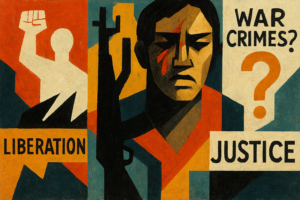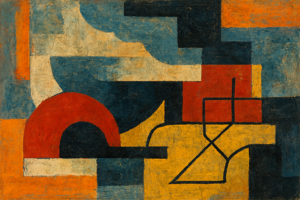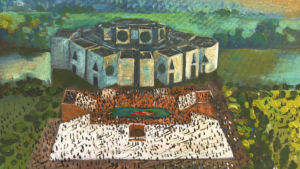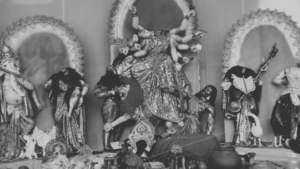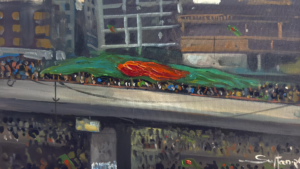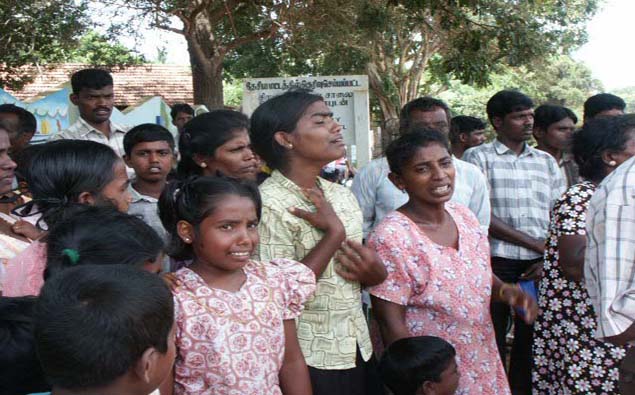
Share the post "Where are the women? The Anguish of Displacement in the CHT and Sri Lanka"
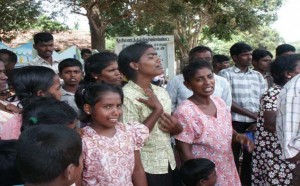 Violent conflicts around the globe displaced a large number of people around the world. Some 43 million people have been driven from their homes by local or cross-border warfare, and the ‘new’ wars dynamic created quasi-permanent refugee population who are spread across the world. The international community needs a much broader and better protection for them. The year 2009, which saw a world total of an additional 15.2 million refugees, was the worst ever in terms of the numbers who returned home voluntarily, mainly because conflicts were becoming more intractable and peace more difficult to achieve.
Violent conflicts around the globe displaced a large number of people around the world. Some 43 million people have been driven from their homes by local or cross-border warfare, and the ‘new’ wars dynamic created quasi-permanent refugee population who are spread across the world. The international community needs a much broader and better protection for them. The year 2009, which saw a world total of an additional 15.2 million refugees, was the worst ever in terms of the numbers who returned home voluntarily, mainly because conflicts were becoming more intractable and peace more difficult to achieve.
In addition, there are some 27 million people who have been forced to flee their homes but are still living inside their own countries as IDPs (Internally displaced persons). This figure does not include people uprooted by disasters like earthquakes and floods, who numbered 36 million in 2008, according to the U.N. Office for the Coordination of Humanitarian Affairs (OCHA). A high proportion of displaced communities are women and children who are ghettoized in horrid camps, slums and other constricted spaces either within the boundaries of their own state as the internally displaced or on the move as either refugees or stateless people in other states.
Women and their children, who are on the move as IDPs, stateless and refugees, account for 80 percent of the global displaced population. Through my own research in various camps and with hidden communities in Kenya (with Sudanese and Somali refugees), Thai-Burma border (with Karen, Kachin, Shan and Rohingya refugees), Pakistan (with Afghan refugees), India (with Sri Lankan refugees and in the Northeast with Reangs, Santals and Bodos), Sri Lanka (with Tamil IDPs), Nepal (with Lhotshampas from Bhutan) and Bangladesh (at the CHT with indigenous IDPs and at the Bangladesh-Burma border with Rohingya refugees), it is clear that displaced women are at serious risk. Unfortunately, gender-based violations of rights of displaced communities, especially in societies emerging from protracted conflicts and militarized environments, have received narrow attention from the media.
The ‘Woman Question’
Women’s bodies are charged with metaphorical meanings profoundly rooted in a social and cultural structure that is outside the physical control of individual women. In times of conflict and violence, women’s bodies often become the carriers of violent messages between different ethnic/other groups. Women’s identity has repeatedly been an important symbol of political and nationalist movements and the construction of nation-states. Sexual torture and rape have been used systematically in South Asian conflicts to influence an enemy nation’s/community’s identity, a process that is evident through the construction of women’s identity within nationalist myths. This is particularly so with regards to the positioning of women within four archetypal roles: as mother, as traitor, as sex object and as target of rape. Over the past three decades, intellectual debates, especially in South Asian historiography, have addressed the limitations of nationalist and state narratives of struggle. In so doing, they have created an awareness of the significance of ‘histories from below’, from those living at the periphery of power and control.
Yet my argument is that not only are these histories critical to the ‘people from below’, but that they are equally important to the whole society, especially for the political elites at the top. Who is visible and who is invisible in public discourses of rights, justice and equality? Where are the women who do not fit into the usual categories of citizenship- as a legally recognised subject of a state for example? Or those, who are considered disloyal to their state, therefore, not worthy of equal rights?
‘Freedom from Fear’: The Chittagong Hill Tracts
Bangladesh has now started looking into the questions of justice and accountability with regard to the Liberation War of 1971. The present government has tried and hanged five killers of Sheikh Mujibur Rahman in early 2010. Also, Sheikh Hasina vowed that all other fugitive killers will be brought to justice. Questions naturally arise, when will the people of the CHT have their justice, and their closure? And what about the women whose lives were shattered by the conflict in the CHT?
The first ‘Life is not Ours’ report published by CHT Commission in 1991 states that looting, arson, rape, gang-rape, torture to death and murder had been used to evict indigenous people from their land in 1990. It cited one such event on December 28, 1990 when three Chakma girls aged between 12-18 were gang raped by eight VDP Personnel posted at number 10 sentry post. They were mutilated and killed along with a ten year old boy. While it is not clear if the boy was raped or not, the public nature of the killing and the mutilation suggest that the incident was used to create fear by the state. The report also cites other incidents of violence against children. The report cites interviews of refugee women taken in Tripura. Women recounted stories of rape, gang rape, assaults committed in front of children and forced marriages.
One of the women stated to the CHT Commission, ‘About 50 army personnel came in the night and rounded up the whole village and gathered us in one place. In the morning all the men were arrested. I was tied up hands and legs, naked. They raped me. There were three women there. They raped me in front of my father-in-law. After that we were tied up together, naked, facing each other. Then they left. Three other girls were raped in front of me. This happened in the month of Ashat (June/July) of 1985.’ It is clear that the trauma of sexual violence affected the men and children equally.
Women were displaced and dislocated through forced marriages to the Bengalis. While this was used as a strategy to change the demography of the CHT, it also created anxieties about religious identity. Many women reported that they were forced to convert to Islam. There were some reports of a secret memo circulating among the army officers encouraging them to marry the indigenous women. One women told the Commission, ‘I was kidnapped in 1986…. I had two children with this man. One day he sent me to his father’s house and at a certain moment when I saw no one around I escaped. I went back to the jouta khamar (cluster village) where I had lived before, but when I arrived there, there were no tribals and it was occupied by Muslims. I arrived here in the camps in 1988.’
While SGBV and other kinds violence resulted into displacement and also continued after displacement/dislocation, the situation had improved only slightly following the 1997 Accord. The military retains a huge presence which has strained the fragile peace and led to violations of Accord. The Peace Accord did not provide any transitional justice mechanism to address the gender based violence of the CHT conflict. Most importantly, even after the accord had been signed, violence against the indigenous community and its gendered manifestations are everpresent in the CHT.
On 12 July 2006, the army tortured and brutalised a shopkeeper in Mahalchari. Similarly there are reports of assaults and rape of indigenous women by the settlers or by the army men. A women from Marma tribe was gang-raped on 30 June 2006. Also, illegal plain settlers attacked seven indigenous villages of Sajek Union under Baghaichari sub-district in Rangamati on 20 April, 2008. During this attack, at least 500 houses were burnt down and an unknown number of women were sexually assualted. It was clear that sexual violence was used as a way to intimidate people to leave their land.
According to the Life if not Ours update published in 2000, ‘no provisions have been made for a) proper investigation of massacres and other human rights violations of the past, b) the trial and punishment of perpetrators and c) compensation for those who have been affected by these human rights abuses’ in the Accord. It further states, ‘Nor are there provisions for making publicly available the reports of the official inquiries into some of the massacres, human rights violations, disappearances and tortures, such as the official report on the 1993 Naniarchar massacre’, and the report concerning the abduction and disappearance on 12 June 1996 of Kalpana Chakma, an activist of the Hill Women’s Federation from her home at Lallyaghona village by the members of the Bangladesh Army. Kalpana’s disappearance generated the most united response by the CHT advocacy groups for the state to take some action. State responses were rather muted and Kalpana Chakma is still missing. There are also no provisions for monitoring any future incidents of human rights violations or for accountability regarding human rights abuses.
‘Freedom from Want’: Sri Lanka
The final offensive of the Government of Sri Lanka (GoSL) against the LTTE have ended, one of the longest running civil war in the battleground of Kilinochchci in May, 2009. However, the intractable conflict that continued for nearly three decades has left a deeply traumatised community, economically devastated and highly militarised state, and a bitter divide along ethnic lines that an ‘official’ ending of war could not easily resolve.
While the war has officially ended for the government, the question is has it ended for its population who were caught between? Who has it ended for and for whom has it been continuing? Where are the forcibly displaced women in the quest for peace and justice in Sri Lanka? According to an Amnesty Report published in 2002, among the victims of rape by the security forces are many internally displaced women, women who admit being or having been members of the LTTE and female relatives of members or suspected male members of the LTTE. Some reports of rape in custody concern children as young as 14. Over the last two decades, the scales of brutality against female recruits of the LTTE had increased significantly.
The leader of the Women’s Political Wing of the LTTE, Subramaniam Shivathai, alias Thamilini was taken into custody from the Vavuniya IDP camp on May 27, 2009. Subramaniam Shivathai alias Thamilini joined the LTTE in 1991 and was trained in Nirvelli. After Nesmia’s death in a battle in Muhamalai, she became the leader of the LTTE Women’s Wing. During her interrogation she stated that she threw away her cyanide capsule and gun, and moved to the camp as an IDP. The GoSL suspects that LTTE members are still hiding in the camps.. Therefore, the camps are heavily guarded, and people in the camps are seen as suspects, without deserving rights and protection. Horrific stories of women and children in camps being gang raped, stripped naked and paraded in public in order to warn others; kidnapping; and disappearance have trickled out of Sri Lanka by Tamil and non-Tamil sources. It is evident that women, especially the displaced women have been disproportionately affected in the Sri Lankan conflict.
Also, there are many ‘war widows’ who remain displaced in Sri Lanka. The numbers of female-headed households are increasing in Sri Lanka with some 40,000 in the North, according to the Center for Women and Development. More than 89,000 women are now looking for jobs. The Association of War Affected Women (AWAW) is advocating for women’s rights. Also several organisations have come forward with $100 grants to assist women open small businesses or find agricultural land for women farmers.
Similar to the CHT, questions of justice remains for displaced women of Sri Lanka. Amnesty report published a decade ago states, ‘Seventy-year-old Poomani Saravanai, an internally displaced widow, was raped by two soldiers at Neervely, Jaffna district in front of her son on 31 May 2000. The next day, she courageously made a complaint at the Atchelu army camp. She was able to identify the two soldiers on that day. It is reported that they were sacked from the army. However, nothing further was done at this crucial initial stage. It was not until 5 and 6 June that Poomani Saravanai was taken to a DMO. By then no evidence of rape could be found. To Amnesty International’s knowledge, the police did not initiate any action against the two soldiers.’ They face various kinds of social stigma, isolation, economic hardship, demands from the family and sexual harassment to make life in the camps doubly difficult. In general, only 10% of conflict-affected widows received assistance from either NGOs or government agencies. The number is significantly lower within the camps. Often unable to find employment, they frequently depend entirely on charity and are more easily targeted for exploitation.
Women’s lives in refuges camps, detention centres and in captivity must be analysed in the broader context of gender, conflict and violence. How much attention do women’s interests receive after conflicts have ended? Where are the women in peace negotiations? Women who have taken part in resistance and nationalist movements and in the construction of their nation-states’ identities in post-conflict periods often have often done so in accordance with parameters or on an agenda largely framed by their countries’ elite, which mostly comprised men. The position of women has therefore always revolved around performing support tasks in their communities. In South Asian conflict zones, such as Pakistan, Kashmir, Sri Lanka, Nepal and the CHT in Bangladesh, the state-initiated relief and rehabilitation programmes aimed at enabling women to generate income are all heavily built on the sexual division of labour, with women performing traditional feminine roles within their communities – e.g., sowing, cooking, paddy husking or even secretarial jobs. Despite decades of gender activism and empowerment strategies, why don’t states allow displaced women to relandscape their lives in a way that is meaningful for them? I believe, states deliberately exclude displaced women from their empowerment and emancipation agenda, to control possibilities of future political resistance. When will women’s war ever end?
Image Source: http://commons.wikimedia.org/wiki/File:Gathering_of_IDPs.jpg

